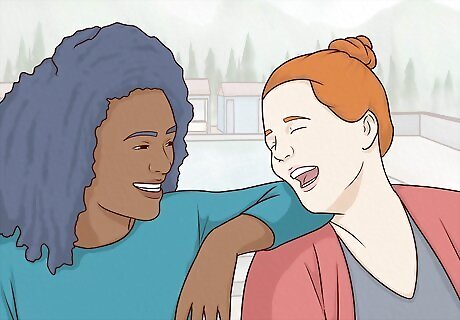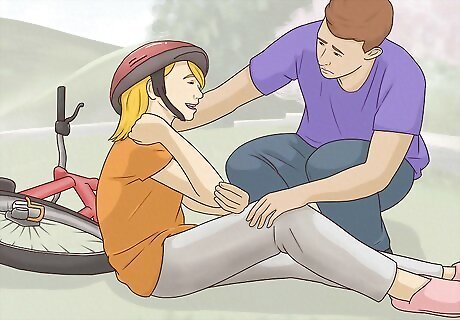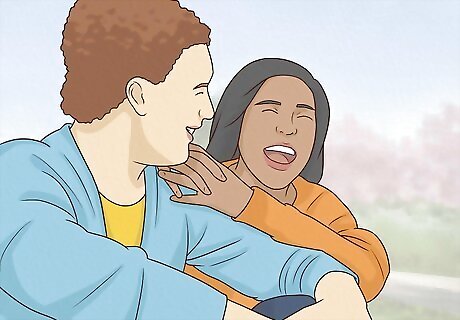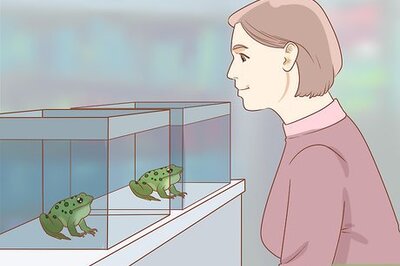
views
Different Types of Laughs

Consider the “Wheeze” laugh. The “Wheeze” laugh tends to come from folks who aren’t able to laugh a lot because of their work or home environment. This type of laugh also tends to come from someone with a great sense of humour. They laugh in such a way that they can’t help but almost suffocate from their laughter and can find themselves crying because they’re laughing so hard. This type of laugh can be accomplished by attempting to hold your laugh in for as long as possible, then suddenly exploding in laughter that makes you out of breath. The key here is to tighten your vocal cords so the sound of your laugh comes out more like you’re having trouble breathing. This type of laugh usually also involves wanting to cover up your face while you’re laughing, because you’re embarrassed you’re laughing. And this type of laugh usually causes your eyes to water.

Create a laugh that’s contagious. A contagious laugh is often one that is so hilarious in and of itself that others start laughing simply because the laugh is hilarious — it doesn’t matter what the funny thing was that started the laugh in the first place. Most people with this type of laugh may try to suppress them at first, but when they can no longer hold it in, it explodes. This laugh is more about the noise your make and less about how you look while laughing. The key to this laugh is to make the most crazy sound imaginable while laughing. It is this crazy sound that makes the laugh contagious because other people will start to laugh at you laughing. This laugh can also start with an attempt to hold the laugh in which then results in a sudden explosion of crazy laughter. This laugh needs to look and sound natural. You also need to avoid looking embarrassed about the sounds your making. This is the type of laugh where the person making the crazy sound doesn’t care that they’re making a crazy sound.

Develop a performed laugh. You probably already have this type of laugh in your repertoire. This is the type of laugh that may sound a little fake, but you’re trying to be polite to the person who said something funny. This type of laugh tends to have a lot of expression in the mouth, but none in the eyes. This laugh might be one of the easiest to perform because it is essentially fake. This laugh requires that you separate the expression in your eyes from the expression your mouth makes. Your mouth should show laughter, but your eyes should not. The laugh itself needs to sound pleasant, but not exuberant. It needs to be polite, but not overwhelming.

Settle for nervous-sounding laughter. For some people this type of laugh is natural, but for others this may be the laugh that suddenly comes out when they realize they’ve made a mistake. The laugh almost sounds like a baby crying and the face doesn’t always look happy, even though the person is laughing. To try this laugh it might be best to pretend you’re embarrassed over what you’re laughing about. Imagine someone slipping on the ice, or walking into a glass door. You shouldn’t laugh, but the action was funny. This laugh requires that you try to keep your facial expression neutral, but you are going to fail. Instead of looking happy though, you want to look embarrassed and/or nervous.

Work on a child-like laugh. This type of laugh tends to come from folks who have some child-like behaviours. The laugh is usually sudden and impulsive, and the person laughing can almost look embarrassed that they did laugh. But in reality they aren’t embarrassed, they’re just being mischievous! When attempting this laugh, take the time to pretend like you want to hide your laugh, but in reality you don’t. You want to look at the people around you in such a way that they also find humour in whatever it is that you’re laughing about. The sound of this laugh is very playful and child-like. And people who make this type of laugh tend not to care that their laugh sounds child-like.

Stick to the old stand-by — giggling. Giggling doesn’t usually result in a lot of facial expressions or body movements. In fact, most gigglers tend to be a little shy and possibly embarrassed that they’re laughing at something — possibly because the thing that made them laugh is something they shouldn’t be laugh at. You might want to watch some old movies where a “proper” lady finds something funny and starts to giggle. Gigglers need to look like they’re shy or trying to maintain their decorum, but are overcome with the humour of the situation and can’t help buy giggle. Giggles shouldn’t end up too loud or obnoxious, but can be done in such a way as to be contagious and start other people laughing as well.
Practicing Your New Laugh

Study the laugh you want. Before you can change your laugh, you need to study your possible options. You might do this by watching movies or TV shows, sitting in a coffee shop and ‘people watch,’ or watch YouTube videos. Observe how other people laugh and what you like and dislike about each type of laugh.

Test various different vocal tones. Just because someone else sounds good with a certain laugh doesn’t mean it’ll work for you. You may need to alter the way you laugh based on the tone of your voice. Try laughing in different tones (and volumes) to see what sounds good to you, and to determine what works best for you. Sometime what we hear coming from ourselves, and what other people hear coming from us, is different. You may want to record yourself trying out various tones and playing them back to get a better sense of how you’ll sound to other people.

Practice the laugh over and over. At this point you probably have a good idea of what kind of laugh you’d like to develop and at what tone you want to use for that laugh. Now it’s time to practice. — over and over and over. Practicing will help accomplish two things: making your laugh sound natural and help your new laugh become instinctive. You may want to consider watching yourself laugh in the mirror to watch the way you move your face muscles and change your facial expression. This is another step where recording your laugh and playing it back may be useful as it’ll give you a better sense of how to sound to other people.

Share your new laugh with friends. Start using your new laugh in the presence of friends and family. Gauge their reactions to your new laugh. Alter your laugh based on their reactions. For example, if they give you funny looks when you laugh, maybe your laugh doesn’t sound natural or maybe it doesn’t suit you.

Use your new laugh as often as possible. Continue practicing your new laugh until you don’t even have to think about it. Use your new laugh in ever social situation you can. Eventually your new laugh will become as instinctive as your old laugh.
Understanding Your Laugh and Laughter

Communicate emotions. Laughter is a lot more than simply the response to a joke or something funny. Laughter is an important part of human emotional communication. It’s so important to us that we’ve developed dozens of emojis and texting terms to express different types of laughter. Humans tends to laugh more often when there are other people around who are also laughing. Yet that laughter isn’t always directed at hearing or witnessing something funny (i.e. a reaction). Laughter is used more as a behaviour that we use in social settings to express how we feel and what we’re thinking.

Interpret fake laughter. The human brain is capable of determining the difference between a real and a fake laugh. We do this in an attempt to understand why someone would need to perform a fake laugh. In other words, we’re trying to comprehend what that fake laugh means.

Spread the laughter. Laughter is most definitely contagious. And scientists believe that those who tend to be “infected” with laughter are also those who are better at telling the difference between real and fake laughter.

Laugh to relieve pain. Laughter has actually been shown to reduce the amount of certain stress hormones in your body like: cortisol, epinephrine and dopamine. And it increases certain types of healthy hormones like endorphins. Laughing also increases blood flow which, in turn, increases a sense of relaxation. Laugh and you’ll not only find yourself feeling better, you might actually help reduce pain and inflammation and get a better night’s sleep.

Enhance your relationships with laughter. Laughter is a social behaviour. It brings humans together and makes people more relaxed around each other. It can also create or enhance the relationship two people have with each other, because they are actually happy to be in each other’s company. Plus, laughing can help reduce or eliminate anger and anxiety, which in turn can help bring about moments of intimacy. Scientific research has found that women actually laugh more than men, 126% more in fact. Men, on the other hand, tend to be the ones attempting to make women laugh by saying something funny or witty — or really stupid, which could have the same effect! As people get older they tend to laugh less. Older people also tend to respond less to tickling.



















Comments
0 comment